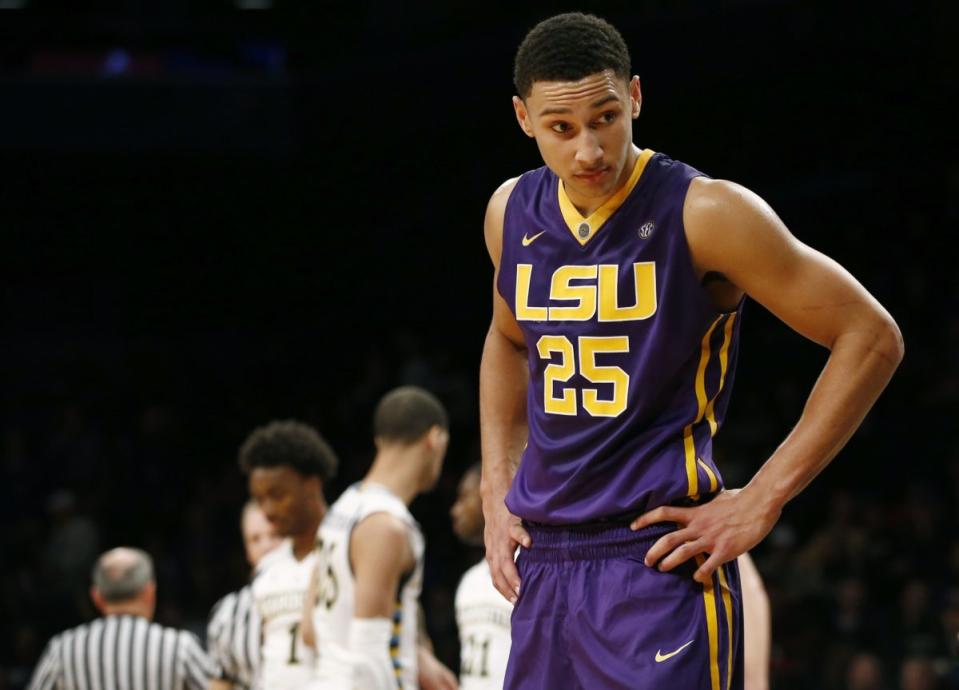Ben Simmons' year at LSU shows the worst of the one-and-done system

The more Ben Simmons speaks about his lone season at LSU, the clearer his legacy in college basketball becomes.
This year’s No. 1 draft pick is a living, breathing monument to the hypocrisy of the flawed one-and-done system.
He arrived at LSU with little desire to achieve anything more than showcasing his talents to NBA scouts. He stopped attending classes as soon as he had guaranteed his eligibility for the entirety of his freshman season. And he escaped punishment for it because LSU was more interested in profiting from his presence on its basketball team than making sure he received an education during his brief time on campus.
In “One and Done,” a documentary about his path to the NBA that will air Friday on Showtime, Simmons grouses that for him college was “pointless” and “wasting time.” ESPN.com received the documentary ahead of time and provided the following excerpts.
“Everybody’s making money except the players. We’re the ones waking up early as hell to be the best teams and do everything they want us to do and then the players get nothing. They say education, but if I’m there for a year, I can’t get much education.
“I’m here to play. I’m not here to go to school.”
Simmons kept his GPA high enough to remain eligible after the fall semester of his freshman year, however, he seldom went to class during spring semester. At one point in the trailer, he remarks, “I have to be getting better every day. I’m not worried about my oceanography class.”
Even though Simmons has a strong argument about the need to relax rules preventing college athletes from earning what they’re worth, here’s what rings hollow about his stinging criticism of the NCAA: For him, attending a U.S. college was a choice, not a necessity.
Simmons could have entered the 2015 NBA draft had he attended high school in his native Australia instead of enrolling at a prep school in Florida. Or he could have turned pro after his senior year at Montverde Academy and spent a year playing in the D-League or overseas.
But instead, Simmons chose to play last season at LSU, where his godfather David Patrick was an assistant coach. And while that doesn’t negate his right to lambast an exploitative system, it does make it tougher to swallow some of his complaints about being forced to play for free or being made to attend classes.
By making no attempt to complete the spring semester, Simmons revealed plenty about his own character. He clearly had no qualms about damaging LSU’s APR score, which if it drops low enough could saddle his former teammates and coaches with scholarship restrictions or even a postseason ban.
Of course, LSU is far from blameless here. From the start, it was obvious the Tigers were only interested in how many points Simmons could score and how many seats at the Pete Maravich Center he could fill.
Before Simmons even arrived on campus at LSU, the school launched an advertising campaign designed to profit from the future No. 1 draft pick’s imminent arrival. “The 25 is Coming” advertisements and billboards were a blatant reference to Simmons’ jersey number aimed enticing fans in Baton Rouge to purchase season tickets.
Simmons largely exceeded expectations from a statistical standpoint, but his 19.2 points, 11.8 rebounds and 4.8 assists per game did not translate into team success. Talent-laden LSU spent most of SEC play yo-yoing between the thick of the NCAA tournament picture and the fringes of it before falling off altogether with a three-game losing streak against mediocre competition in late February and a listless 71-38 loss to Texas A&M in the SEC quarterfinals.
Even as Simmons stopped attending classes and demonstrated minimal effort and poor body language on the court, the LSU coaching staff did not hold him accountable. The most dire punishment he received? Being benched for the opening four minutes of a Feb. 20 game against Tennessee because of “academic stuff.”
One of the worst parts of this Simmons story is that it will color how other one-and-done prospects are viewed when many are nothing like him. For every hired gun who treats his lone year of college as an obstacle to be endured, there are other elite NBA-bound prospects who immerse themselves in the college experience for however long they’re on campus.
Ultimately, the NBA’s requirement that draft entrants must be 19 years old and a year removed from high school is a flawed rule with good and bad consequences.
Among the positives: Prospects who attend even one year in college gain the maturity and life experience necessary to handle living on their own with a seven-figure salary while still in their teens or early 20s. Plus, college basketball often provides a badly needed reality check to prospects who are convinced they’re prepared for the rigors of the NBA when really they need a couple more years of seasoning.
Among the negatives: Prospects who truly are NBA-ready after high school forfeit a year of earning potential, something that would never happen to prodigies in other walks of life. Furthermore the educational component of college athletics vanishes when a one-and-done prospect doesn’t even bother to show a shred of interest in working toward his degree.
For better or worse, Simmons’ lone year at LSU personifies all that is wrong with the one-and-done rule. With every detail that slips out, that only becomes more apparent.
– – – – – – –
Jeff Eisenberg is the editor of The Dagger on Yahoo Sports. Have a tip? Email him atdaggerblog@yahoo.com or follow him on Twitter!



